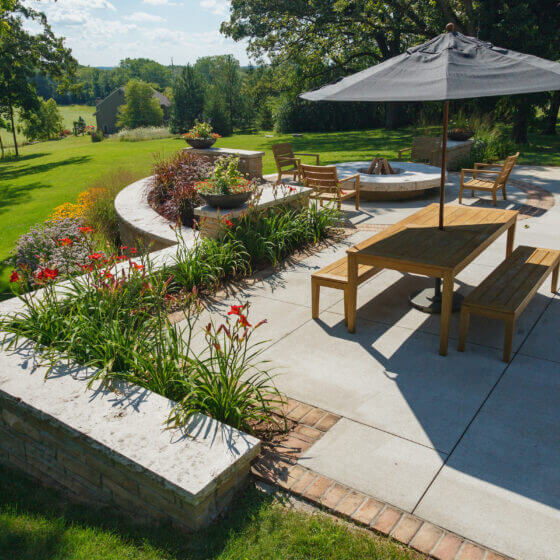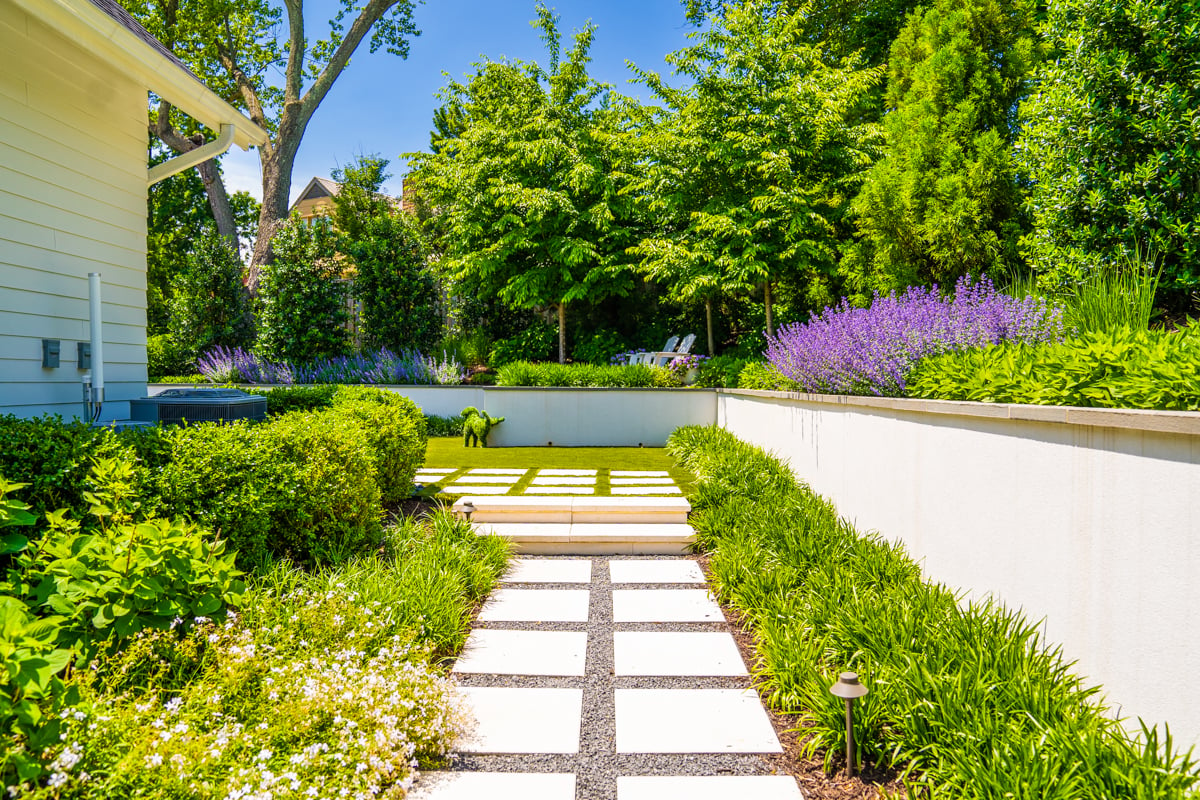BBQ Island Installation Designs That Blend Style and Functionality
Wiki Article
Checking Out Different Sorts Of Landscape Design to Enhance Your Outdoor Atmosphere
Landscape design plays a crucial role in defining outdoor spaces. Numerous styles, from traditional gardens to modern-day minimalist layouts, use distinct benefits for improving looks and function. Integrating elements like xeriscaping and indigenous plants can add to eco-friendly equilibrium. Understanding the interaction of hardscape and softscape is essential for developing welcoming settings. The selections readily available can be overwhelming, prompting one to assess which style best lines up with their vision for an outside refuge.Typical Garden Landscaping

While many contemporary yards welcome minimalism and native plantings, typical garden landscape design stays a treasured strategy that highlights symmetry, framework, and decorative features. This design commonly incorporates formal geometric designs, where pathways, flowerbeds, and hedges are organized with accuracy. Central prime focus, such as sculptures or fountains, draw the eye and give a feeling of harmony.Traditional landscaping often consists of a selection of plant kinds, showcasing seasonal blooms and evergreen aspects. Classic hedges, perennials, and annuals develop vivid colors and textures throughout the year. Furthermore, trellises, pergolas, and arches include upright interest and function as support for climbing plants, enhancing the total aesthetic.The use all-natural products, such as stone and wood, additional enriches the traditional landscape, contributing to a classic quality. Inevitably, this style welcomes relaxation and pleasure, making it a cherished choice for those looking for a picturesque outside setting.
Modern Minimalist Landscape Design
Modern minimal landscape design highlights simplicity and capability, characterized by open areas and clean lines. Trick characteristics consist of a minimal plant palette and thoughtful hardscape layout that prioritizes use and visual appeal. Efficient plant option strategies even more improve the minimal approach, developing peaceful outdoor atmospheres that urge relaxation and reflection.Key Qualities of Minimalism
A growing pattern in landscape design is the welcome of minimalism, identified by simplicity and capability. Minimalist landscape design concentrates on clean lines, open areas, and a minimal shade combination, promoting a sense of serenity. Components are meticulously curated to prevent clutter, permitting each component to stand apart. The usage of natural products, such as stone and wood, enhances the natural feeling while preserving an aesthetic balance. Furthermore, minimalist styles often integrate geometric shapes, which can create aesthetic passion without overwhelming the senses. Water features might be included, acting as centerpieces that enhance peacefulness. Generally, minimalism in landscaping emphasizes the beauty of restriction, enabling nature's intrinsic qualities to beam through in an unified outside setting.Plant Selection Techniques
Effective plant option is necessary for achieving the wanted visual in modern-day minimalist landscaping. The emphasis ought to get on simpleness, using a restricted palette of plants that enhance each other and the surrounding atmosphere. Indigenous plants are often suitable, as they require less maintenance and water, promoting sustainability. Selecting varieties with varying heights and appearances can include visual rate of interest without overwhelming the area. Organizing plants in clusters instead of scattering them boosts cohesion and strengthens the minimal style. Evergreen selections can supply year-round framework, while seasonal flowers present refined shade changes. Inevitably, the goal is to develop a calm exterior room that symbolizes serenity and consistency with thoughtful plant selections.Hardscape Style Principles
Crucial components in hardscape layout substantially add to the general visual appeals and capability of minimal landscaping. This layout method stresses clean lines and understated materials, creating an uncluttered aesthetic experience. Key parts include paths, patio areas, and retaining walls, which not only specify rooms yet additionally boost ease of access and use. The usage of products such as concrete, stone, and wood is prevalent, showing a natural yet contemporary visual. Incorporating in proportion formats and geometric shapes additionally reinforces the minimal approach, permitting for an unified mix with surrounding plant. In addition, appropriate drain and disintegration control are essential considerations, guaranteeing long life and sustainability. Ultimately, reliable hardscape design offers as a foundation that complements softscape elements while preserving balance and simpleness in outdoor environments.
Cottage-Style Landscaping
Cottage-style landscape design offers a fascinating approach to developing inviting outside spaces. By incorporating enchanting plant mixes, this design fosters a feeling of warmth and fancifulness. The focus on relaxing, distinct locations encourages leisure and satisfaction of nature.Captivating Plant Mixes
Many house owners seek to produce a picturesque exterior area, achieving the beauty of cottage-style landscaping typically pivots on thoughtful plant combinations. Lively blooms, lush foliage, and fragrant natural herbs can be artfully matched to evoke a sense of whimsy and fond memories. Incorporating lavender, sissies, and foxgloves produces a vivid tapestry that attracts pollinators while giving a delightful scent. Integrating decorative yards like miscanthus can add structure and motion, complementing the softer blossoms. Additionally, mixing yearly and seasonal plants assurances continuous shade throughout the periods. Making use of mountain climbers, such as clematis or honeysuckle, can boost vertical interest. On the whole, these mixes not only improve the landscape but also cultivate a captivating and inviting atmosphere.
Comfy Exterior Areas
Developing cozy outside areas calls for a careful mix of comfort and charm, matching the dynamic plant combinations discovered in cottage-style landscaping - Outdoor Lighting Installer. These areas usually include welcoming seating plans, such as weather-beaten wood benches or supported chairs surrounded by lavish greenery. Soft lights, like fairy lights or lanterns, includes heat, changing the area right into a tranquil retreat. Integrating aspects such as trellises adorned with climbing up roses or fragrant natural herbs enhances sensory experiences. Furthermore, paths made from rustic stones invite exploration and connection with nature. Ornamental touches like birdbaths or whimsical yard art add to a sense of whimsy. Ultimately, the objective is to develop a captivating environment that urges leisure and pleasure of the appeal surrounding these comfy outside sanctuariesXeriscaping for Water Preservation
Just how can communities balance visual landscaping with journalism demand for water conservation? Xeriscaping emerges as a practical remedy, promoting sustainable methods that reduce water usage while improving click here to find out more outdoor appeal. This landscaping technique concentrates on making use of drought-resistant plants belonging to the area, which call for considerably less water than standard gardens. By incorporating compost and effective watering systems, xeriscaping reduces dissipation and runoff, further conserving precious water resources.Communities can create aesthetically enticing landscapes via mindful preparation, picking a diverse array of textures and colors that grow in dry problems. Additionally, xeriscaping motivates using decorative rocks and attractive crushed rock, supplying functional and appealing choices to turf lawns. As areas accept this green technique, they not just minimize their water consumption yet likewise promote biodiversity and durability Full Article in their regional environments. Eventually, xeriscaping acts as a presentation of the consistency in between visual charm and environmental obligation.Hardscape Style Elements
Hardscape layout components play a vital function in improving exterior spaces by offering structure and functionality. These non-plant attributes, such as patio areas, wall surfaces, pathways, and decks, develop aesthetic interest while serving functional functions. Making use of products like stone, concrete, and block, hardscaping adds to the general aesthetic appeal and toughness of a landscape.Incorporating hardscape components can specify areas within a backyard, guiding motion and urging social interaction. For example, a well-placed path can connect various areas of the garden, while keeping wall surfaces can take care of elevation modifications and avoid erosion.Furthermore, hardscape design can improve ease of access and safety and security, supplying steady surfaces for walking or lounging. Effective assimilation of hardscape components matches soft landscape design, making sure a well balanced outdoor setting. Ultimately, thoughtful hardscape layout improves not just the beauty of exterior rooms but likewise their functionality, making them a lot more inviting and useful for visitors and homeowners alike.Outside Living Areas
While outdoor living rooms offer a seamless blend of convenience and nature, they act as essential expansions of a home, improving lifestyle and leisure. These locations can include patio areas, decks, or outdoor cooking areas, developed to cultivate relaxation and enjoyment. Retaining Wall Installation. By integrating useful furniture and elegant decor, house owners produce welcoming environments for gatherings or quiet evenings.The integration of color frameworks, such as awnings or pergolas, protects versus the aspects while keeping an open feel. Fire pits and exterior heating units extend functionality right into cooler months, providing warmth and setting. Furthermore, integrating lighting attributes improves the space's use after sundown, producing an enchanting night atmosphere.Landscaping aspects, such as boundaries and pathways, additionally define these areas, guiding movement and including visual allure. Inevitably, outside home transform backyards into versatile retreats, advertising a way of living that welcomes both nature and convenienceIndigenous Plant Landscape Design
Native plant landscaping highlights using native vegetation to produce sustainable and unified exterior settings. This strategy not only enhances biodiversity yet additionally preserves water and minimizes the requirement for chemical fertilizers and pesticides. By choosing plants that are belonging to a particular region, home owners can ensure that their landscapes are well-adapted to neighborhood dirt and climate conditions, causing lower maintenance requirements.Additionally, native plants supply essential environments for regional wild animals, consisting of birds, butterflies, and , promoting ecological health and wellness. Landscape designs that integrate these plants frequently feature naturalistic formats that resemble regional environments, promoting a local color and link to the environment.Furthermore, native plant landscaping can contribute to soil stability and erosion control, making it an eco accountable selection. On the whole, this technique not just improves outside spaces but additionally supports the neighborhood environment, developing a sustainable balance between human task and nature.
Often Asked Questions
Exactly How Can I Choose the Right Landscaping Design for My Home?
Picking the ideal landscaping design for a home entails examining the residential property's style, environment, and individual preferences. Retaining Wall Installation. Investigating different designs and seeking advice from experts can supply support to develop a harmonious exterior space tailored to private needsWhat Is the Typical Price of Expert Landscape Design Providers?
The average cost of professional landscape design solutions normally ranges from $1,000 to $5,000, depending on job complexity, dimension, and location. House owners should take into consideration obtaining multiple quotes to guarantee they get reasonable pricing and top quality service.click to read
How Typically Should I Preserve My Landscaped Backyard?
The frequency of keeping a designed backyard usually relies on the functions and plants existing. Generally, regular maintenance every couple of weeks is advised, with seasonal jobs increasing in frequency during peak growing periods for ideal health and visual appeals.Exist Landscaping Choices for Small Urban Spaces?

Numerous landscaping choices exist for small metropolitan areas, consisting of upright yards, container plants, and rooftop gardens. Including these elements can take full advantage of restricted locations while providing greenery, boosting visual appeals, and improving air quality in urban settings.
What Plant kingdom Are Best for Drawing In Regional Wild Animals?
The finest plants for attracting neighborhood wild animals include indigenous flowering species, berry-producing hedges, and diverse grasses. These plants offer essential food and environment, fostering a flourishing ecosystem that supports different birds, pests, and tiny animals. Many homeowners seek to create a picturesque exterior space, attaining the charm of cottage-style landscaping usually hinges on thoughtful plant combinations. Developing comfy exterior rooms needs a cautious mix of convenience and charm, complementing the dynamic plant combinations found in cottage-style landscaping. Native plant landscaping stresses the usage of indigenous flora to create unified and sustainable exterior atmospheres. Landscape designs that integrate these plants frequently include naturalistic layouts that simulate neighborhood communities, cultivating a feeling of area and link to the environment.Furthermore, native plant landscaping can contribute to soil security and erosion control, making it an eco liable choice. Various landscaping options exist for small city spaces, including vertical yards, container plants, and rooftop gardens.Report this wiki page